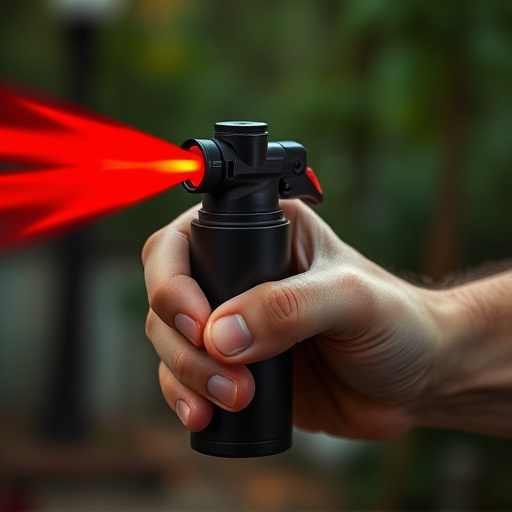Pepper spray, a popular self-defense tool, imparts a burning sensation via capsaicin, with effects typically lasting 20 minutes to an hour. Concentration and environmental factors like temperature, humidity, wind, and reflectivity significantly influence duration. While initial symptoms subside quickly, residual discomfort can last up to 48 hours. Proper usage techniques, including training, aiming, distance, and regulatory awareness, maximize its effectiveness for self-defense.
“Uncover the power of maximum strength pepper spray—a non-lethal self-defense tool that can deter attackers. This comprehensive guide explores the science behind pepper spray, its composition, and how it temporarily incapacitates assailants. We delve into the duration of its effects, revealing what research says about ‘How Long Pepper Spray Effects Last’.
From understanding key factors influencing its longevity to best practices for optimal defense, this article equips individuals with vital knowledge for personal safety.”
- Understanding Pepper Spray: Composition and Mechanism
- The Duration of Pepper Spray Effects: What Science Tells Us
- Factors Influencing Pepper Spray's Longevity
- Best Practices for Maximizing Pepper Spray Defense
Understanding Pepper Spray: Composition and Mechanism
Pepper spray, a powerful defense tool, is composed primarily of capsaicin, the same compound that gives hot peppers their heat. When deployed, it creates a temporary disability by causing intense irritation and pain in the eyes, nose, and respiratory system. The mechanism behind its effectiveness lies in overstimulating nerve endings, leading to a “burn” sensation and subsequent temporary blindness.
The duration of pepper spray’s effects varies but typically lasts from 20 minutes to an hour. Factors influencing this time frame include the concentration of capsaicin, weather conditions, and individual sensitivity. Understanding How Long Pepper Spray Effects Last is crucial for users to be prepared and ensure their safety during potential encounters.
The Duration of Pepper Spray Effects: What Science Tells Us
The effects of pepper spray are designed to be temporary, but understanding how long these effects last is crucial for anyone considering carrying or using it for self-defense. According to scientific studies, the active ingredient in pepper spray, capsaicin, can cause symptoms like eye irritation, difficulty breathing, and pain for several minutes after exposure. The duration of these effects typically ranges from 20 minutes to an hour, although this can vary based on factors such as the concentration of capsaicin, the method of application, and individual sensitivity.
While the initial sting may subside relatively quickly, the residual effects can be more prolonged. Research suggests that some individuals may experience heightened sensitivity or discomfort for up to 48 hours after exposure, necessitating careful consideration when determining if and when to use pepper spray as a defense mechanism. This understanding is vital for users to prepare themselves mentally and physically for the aftermath of deployment.
Factors Influencing Pepper Spray's Longevity
The longevity of pepper spray’s effects is influenced by several key factors, providing insights into its overall effectiveness as a self-defense tool. One of the primary considerations is the concentration of capsaicin, the active ingredient responsible for the burning sensation and irritation it causes. Higher concentrations result in longer-lasting effects, typically ranging from 30 minutes to 2 hours, depending on the product and application method.
Environmental conditions also play a crucial role. Extreme temperatures, whether hot or cold, can impact the spray’s potency and duration. Humidity levels affect how quickly the pepper spray evaporates, with higher humidity potentially reducing its effectiveness. Additionally, wind can cause the spray to dissipate faster, while surfaces like walls or vehicles can prolong its reach, influencing how long it remains active on targeted areas.
Best Practices for Maximizing Pepper Spray Defense
When it comes to maximizing the effectiveness of pepper spray as a self-defense tool, understanding its impact and duration is key. The active ingredient in pepper spray, capsaicin, stimulates nerve endings, causing a burning sensation and temporary blindness. However, the effects are not permanent; they typically last between 20 minutes and an hour. During this time, it’s crucial to take immediate action and create distance from the assailant.
Best practices include ensuring proper training in pepper spray usage, learning how to aim for vulnerable areas like eyes and nostrils, and keeping a safe distance after activation. Additionally, always check local laws regarding self-defense products, as regulations vary. Regularly updating your knowledge on pepper spray defense strategies is essential, as new techniques and advancements emerge over time.
Pepper spray, a powerful self-defense tool, offers significant protection when used correctly. By understanding its composition, duration of effects, and influencing factors, individuals can maximize its potential. Following best practices ensures its effectiveness, providing peace of mind and the ability to defend against threats. Remember, knowledge is key; stay informed about pepper spray’s capabilities and limitations to make informed decisions for your safety.
